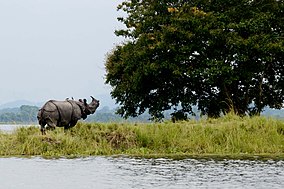
Back حديقة كازيرانجا الوطنية Arabic কাজিৰঙা ৰাষ্ট্ৰীয় উদ্যান Assamese Parque nacional de Kaziranga AST Kaziranqa Milli Parkı Azerbaijani Казиранга Bashkir Taman Nasional Kaziranga BAN Казиранга Bulgarian काजीरंगा नेशनल पार्क Bihari কাজিরাঙা জাতীয় উদ্যান Bengali/Bangla Parc Nacional de Kaziranga Catalan
| Kaziranga National Park | |
|---|---|
 Adult Indian rhinoceros, with a calf at Kaziranga National Park in Bagori range of Nagaon district of Assam, India | |
| Location | Golaghat and Nagaon districts,[1] Assam, India |
| Nearest city | Golaghat |
| Coordinates | 26°40′N 93°21′E / 26.667°N 93.350°E |
| Area | 1,090 km2 (420 sq mi) |
| Established | 1 June 1905 11 February 1974 (as national park) |
| Governing body | Government of Assam Government of India |
| Website | https://kaziranga.nptr.in/ |
| Type | Natural |
| Criteria | ix, x |
| Designated | 1985 (9th session) |
| Reference no. | 337 |
| Region | Asia |
Kaziranga National Park is a national park in the Golaghat, Sonitpur, Biswanath and Nagaon districts of the state of Assam, India. KNP has 5 ranges. The park, which hosts two-thirds of the world's Indian rhinoceroses, is a UNESCO World Heritage Site.[2] According to a March 2018 census conducted jointly by the Forest Department of the Government of Assam and some recognized wildlife NGOs, the rhino population in Kaziranga National Park is 2,613. It comprises 1,641 adult rhinos and 385 calves.[3]
In 2015, the rhino population stood at 2,401. Kaziranga National Park was declared a Tiger Reserve in 2006. The park is home to large breeding populations of elephants, wild water buffalo, and swamp deer.[4] Kaziranga is recognized as an Important Bird Area by BirdLife International for conservation of avifaunal species which refers as the birds or types of birds found in a specific region, period, or environment. When compared with other protected areas in India, Kaziranga has achieved notable success in wildlife conservation. Located on the edge of the Eastern Himalaya biodiversity hotspot, the park combines high species diversity and visibility.
Kaziranga is a vast expanse of tall elephant grass, marshland, and dense tropical moist broadleaf forests, criss-crossed by four major rivers, including the Brahmaputra, and the park includes numerous small bodies of water. Kaziranga has been the theme of several books, songs, and documentaries. The park celebrated its centennial in 2005 after its establishment in 1905 as a reserve forest.
- ^ National Park, Kaziranga. "Kaziranga National Park and Tiger Reserve". Kaziranga National Park. our My India and Peak Adventure Tour. Retrieved 6 April 2019.
- ^ Bhaumik, Subir (17 April 2007). "Assam rhino poaching 'spirals'". BBC News. Archived from the original on 22 November 2008. Retrieved 23 August 2008.
- ^ Dutt, Anonna (30 March 2018). "Kaziranga National Park's rhino population rises by 12 in 3 years". Hindustan Times. Archived from the original on 27 April 2018.
- ^ "Welcome to Kaziranga". Archived from the original on 30 April 2012.

